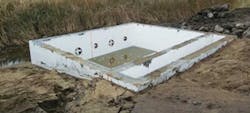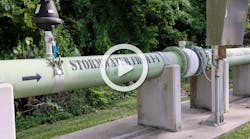About the author: Doug Green is the president and CEO of American Peat Technology. Green can be reached at [email protected] or 218.927.1888.
As every storm water professional knows, the eyes of government are looking ever more closely at water that falls from the sky—what is in it and where it is going. Industry has long had to be concerned with the potential pollution that can emanate from its operations and property. As urban areas are expanding and the acreage of impermeable surfaces increases, everyone—not just big industry—will be held accountable for the pollutants that run off their property.
Some of the most potentially damaging and most difficult to control pollutants in storm water are heavy metals. One of the most damaging aspects of heavy metals is that the pollutants accumulate in the bodies of plants and animals and do not degrade over time. These contaminants remain in the environment even after the plant or animal dies.
Another problem with heavy metal pollution is that many of the current storm water remediation methods do not mitigate it. To be effective, the contaminants must be captured, held and retained. Capturing, holding and retaining the dissolved heavy metals and doing it efficiently, effectively and economically has been elusive and expensive—until now.
A New Option
Early mining operators in pre-industrial America knew that contaminated water from the mining operations would enter a peat bog polluted and come out the other side clean and free from contaminants. What was not understood was what occurred between the contaminated water entering the bog and the clean water leaving it. That code has been broken and the power of peat to leach heavy metals from water has been harnessed to become an asset in the effort to remove the heavy metals that come from street, roof and parking lot runoff.
A new filtering media manufactured by American Peat Technology (APT) uses unprocessed peat to bind and hold dissolved heavy metals from water. The first hurdle that APT had to overcome was that raw peat is an inadequate filtering media. This is due to two characteristics: It has a high affinity for water and a low mechanical strength. Essentially, when mixed with water, it makes an impermeable mud. APT has developed a process to produce a hardened peat granule, similar in consistency to coffee grounds, that makes a good filter: APTsorb.
APTsorb has been tested in the lab and in the field as an ion exchange media. In the lab, it has been effective in removing and holding copper, nickel, cobalt, lead, chromium, cadmium and mercury. Work continues in the lab and on pilot projects to adapt and customize the granule and to widen the range and variety of elements that the media is effective in capturing and holding.
Pilot Projects
Near Soudan, Minn., APTsorb was used to remove copper from water being pumped from a decommissioned mine, which functions now as a historic and tourist site. APTsorb also is being used by Diamond Chrome Plating in Howell, Mich., to remove high concentrations of zinc, cadmium and chromium from the storm water running off its property. Both of these pilot projects either pump the water through tanks containing the media or collect the water to be stored and pumped through the media later. Both projects have been successful in bringing and holding the sites under state and federal permit limits.
A new storm water application is scheduled to be tested in Aitkin, Minn., in the spring of 2014 to remove copper from the storm water running off the parking lot of Paulbeck’s County Market. A passive storm water treatment system is being built that will remove elevated levels of copper and zinc found during testing. The plan is to run the rainwater from the parking lot through the system, using only gravity, and then allow the water to flow into the existing drainage area and watershed. This effort is a collaboration of three companies that have come together to solve a problem and explore new options for treating an ever-growing number of storm water problems.
Paulbeck’s County Market provided the lot, the problem and the willingness to step forward. APT brought in KBI Industries and its permeable pavement material, Flexi-Pave, which will be used to allow drainage through the pavement and get the contaminated water in contact with the APTsorb for the required amount of time to ensure adequate removal of copper and other contaminants.
APT will establish a local test to determine whether its media could be effective in combating copper and zinc concentrations emanating from the cars parking in the lot by using a passive treatment system. The most likely culprit for the copper concentrations is brake dust falling off the cars at the largest and busiest parking lot in Aitkin County, Minn.
Because of poor design, the 119,000-sq-ft parking lot only drained into one corner. The passive treatment system will capture and direct the contaminated water through the system and then back into the established drainage pond and watershed. The proximity to APT’s plant and labs will allow for testing and monitoring before, during and after every rain event. This close monitoring and oversight will ensure accurate and consistent data that will open another use for APTsorb and help APT scientists and engineers to expand and refine use of the media in storm water remediation.
Download: Here


